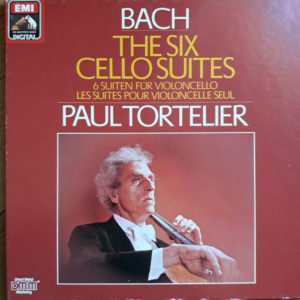
Paul Tortelier.Bach Cello Suites. Release Reviewed CD HMV Classics 7243 5 62879 2 1. Released 2004.
Original release 1983 HMV Digital SLS 1077723 Vinyl.
Recorded April 1982 Temple Church London.
No information about the cello used but no 5 string instrument used for sixth suite.
Introduction.
This recording was Tortelier’s second of the Suites when he was in his late 60s, possibly at the height of his considerable ability. It displays I believe all the characteristics of recordings by virtuosos in the second half of their career. Namely spellbinding technical ability and large dollops of idiosyncratic interpretation.
The Recording.
Firstly, the boring bit. The sound quality is very impressive; aided, the marketing people would no doubt claim by re mastering in this 2004 re issue using the “PRISM SMS sound shaping system”. The cello sound is full, mellifluous, and even over the whole range. No doubt a testimony to the artist.
The venue for the recording probably gives a shade too much echo for my liking. In quieter moments following loud passages there is an impression of echoes in the distance that seem to go on and on distracting the listener.
The music.
What of the interpretation? To my mind this is a text book example of how to make music interesting.
Tortelier uses a wide range of tone, with passages played near the bridge in Courantes to give a scratchy cross string sound that draws the attention.
There is full bodied tone in the Preludes, and sparse desolate sound in some of the Sarabandes.
Tortelier employs plenty of legato playing interspersed with detached staccato passages.
There is considerable rubato and liberties with timing in most movements, together with significant contrasts in dynamics.
The shaping and phrasing is as with Tortelier’s first recording an exemplar of how these Suites can be made so fascinating to even a casual listener.
There is also quite an unusual degree of emphasis on key notes. Not accented in an ugly manner as by some other artists, but leant into in a very obvious way.
A little bit of Theatre.
I can summarise this by describing the playing and interpretation as theatrical. Everything seems a little over the top and exaggerated.
A measurable example of this, is the tempos used. For example, the fourth Suite Prelude is played very slowly whilst the sixth Suite Courante very fast. This second recording is a full 21 minutes longer in total than the first, so slower predominates!
In my mind there are comparisons to be made with the actor Sir John Gielgud who in his later years was greatly admired for a large number of cameo roles which employed his great ability to communicate volumes with simple but exaggerated facial expressions and inflexions of his voice.
Conclusion.
Does this all add up to a musical interpretation that stirs the soul? Not quite as far as I am personally concerned. I prefer the first rendition for serious listening but this second recording is certainly one to play loudly if one wants to demonstrate the power of your sound system or you need re-vitalising.
Charles.